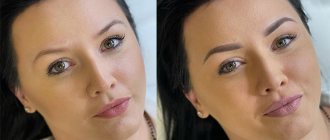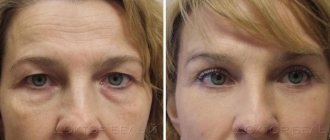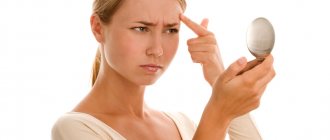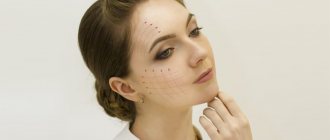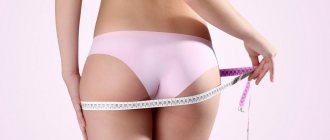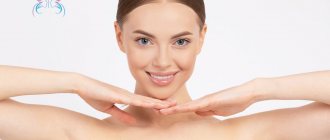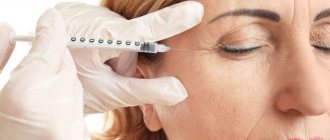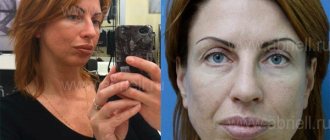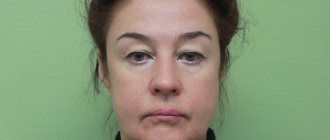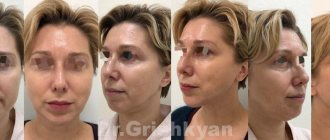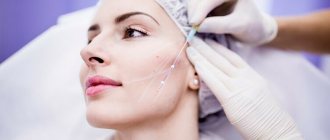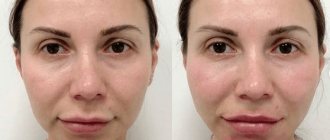Eyebrow lifting with threads is a minimally invasive, gentle cosmetic procedure. The essence of the technique is the subcutaneous implantation of a material biocompatible with the human body, which allows you to eliminate sagging of the upper eyelids, raise the corners of the eyebrows, and smooth out facial wrinkles in the forehead and between the eyebrows. Thread lift is a safer alternative to plastic surgery, as it does not require radical surgery and long-term rehabilitation. The procedure is prescribed to patients with pronounced age-related changes in facial skin. For lifting, different types of threads are used, which are selected for each patient personally, taking into account individual characteristics.
What is eyebrow lifting with threads?
Brow lifting with threads is performed to remove cosmetic defects associated with age-related skin changes. The procedure can be performed under general or local anesthesia, it all depends on the type of threads used and the individual characteristics of the patient’s body.
Threads biocompatible with the human body are implanted under the skin, which are securely fixed in the soft tissues, providing a pronounced effect of lifting the eyebrow arches and smoothing out deep wrinkles in the forehead and between the eyebrows. The effect of the procedure is noticeable almost immediately: the patient gets rid of a heavy, tired look, and the face looks more fresh, rested, and rejuvenated. Eyebrow lifting with threads is performed at the age of 35–40 years, when the signs of gravitational ptosis are noticeably expressed.
After the procedure, facial expressions in the area of the eyebrows and forehead remain natural. The technique does not require long-term rehabilitation, and if the implantation technology is strictly followed, it practically does not cause side effects. For eyebrow lifting, cosmetologists at the International Hemostasis Clinic use the most modern, safe, well-proven threads, which allow you to achieve the desired effect by postponing radical surgical intervention.
Threadlifting Mesothreads with multi-directional notches 1 piece 3,300 rub. Consultation with a cosmetologist, subject to the provision of the service on the day of consultation 0 rub.
All prices Make an appointment
Involutional processes in the periorbital zone in most cases begin with drooping of the lateral part of the eyebrow. What are the possibilities of thread lifting in eliminating this aesthetic defect?
In what cases does the use of threads have serious limitations? How is a thread lift of the lateral eyebrow performed correctly: what does the clinical experience of doctors suggest?
The recommendations are based on a summary of many years of clinical experience of doctors at the Dr. Gruzdev Clinic (St. Petersburg) in the field of using threads to correct the position of the eyebrows, including lifting their lateral parts.
The purpose of the procedure is thread lifting of the eyebrows (the lateral part (tail) of the eyebrow) with simultaneous tightening of the skin of the upper eyelid and smoothing out wrinkles in the lateral corner of the eye.
Eyebrows are one of the most expressive parts of the face. A well-shaped eyebrow line emphasizes beauty and youth and enlivens the look. Involutional processes in this zone in most cases begin with a drooping of the lateral part of the eyebrow, which gives the face a sad expression and ages it. Often this process is aggravated by parallel developing true blepharochalasis. Thread lifting of the lateral part of the eyebrows is a minimally invasive method for correcting this aesthetic defect.
Brow lift: indications for the procedure - thread lifting
- Brow lift: indications for the procedure:
- drooping of the eyebrow tail as a result of age-related changes in the facial area or as a congenital aesthetic defect;
- ptosis of the skin in the area of the fixed part of the upper eyelid, associated with ptosis of the tail of the eyebrow;
- deep wrinkles in the area of the lateral corner of the eye associated with ptosis of the tail of the eyebrow;
- the patient's desire to change the shape of the eyebrows.
Contraindications to the procedure - thread lifting
Absolute contraindications (generally accepted for all thread methods):
- cancer;
- pregnancy;
- lactation;
- decompensated state of the cardiovascular system;
- acute inflammatory process;
- local inflammation in the area of the procedure;
- allergic reaction to the thread material.
Relative contraindications are features of the patient’s face in which the following negative aesthetic effects of the procedure are possible:
- unacceptable eyebrow placement. For example, if the distance from the scalp to the eyebrows is small, as a result of the procedure the eyebrows may end up in the middle of the forehead. A similar result can be expected with an initially high eyebrow position or highly executed permanent makeup;
- eyebrows may acquire an unattractive bend - for example, a sharp bend in the middle of the eyebrows like “Mephistopheles’ eyebrows”;
- slight retraction (displacement) of the skin in the area of the lateral part of the eyebrows.
If there are relative contraindications and the absence of absolute ones, the doctor, based on his personal experience, taking into account previously obtained results, makes a decision: a thread brow lift is possible or it is better to refuse it.
Hygienic requirements for the procedure - thread lifting
A brow lift with threads is performed in a treatment room.
When preparing the office you must:
- provide sufficient lighting;
- carry out quartzing of the cabinet;
- when preparing the procedure table - lay out threads, sterile instruments, sterile napkins,
- antiseptic solution onto a sterile sheet without touching it with your hands.
When preparing a patient for the procedure, it is necessary:
- carry out facial makeup removal;
- treat the correction area with skin antiseptics (such as betadine, alcohol solution of chlorhexidine, AHD 2000);
- limit the procedural field with adhesive bandages in the area of the scalp to prevent hair from getting into the wound and contact of hair with threads;
- shave the area of skin in the puncture area, and treat adjacent areas with hair with betadine.
The doctor performs the procedure in a gown, mask and gloves, which must be sterile.
Aesthetic requirements for the result of the procedure
Correction of the position of the eyebrow tail is carried out taking into account the individual characteristics of the patient. The optimal eyebrow line is determined by the shape and type of the patient's face. For example, when correcting the position of the eyebrows on an oval-shaped face (usually a European type), it is necessary to achieve an arched eyebrow line; with an Asian type of face, patients usually prefer highly raised lateral edges of the eyebrows. The main requirement is that as a result of the procedure, the position of the eyebrows should not be disharmonious with the overall appearance of the face.
Threads used
A pronounced aesthetic effect of the lift is provided (see – Characteristics of threads according to the CHRIST classification):
– lifting threads of modification “C” – with two needles, pointed on one side (for example, Aptos Thread 2G, Spring Thread, Happy Lift Double Needle, Silhouette Soft); – lifting threads of the “H” modification – with two double-edged needles (for example, Happy Lift i-Needle, Aptos Needle 2G).
Eyebrow lifting with Aptos threads can be carried out using reinforcing threads of modification “I” (for example, Aptos Excellence Elegance, Aptos Excellence Visage, Happy Lift Free Floating and polydioxanone threads with counter-positioned notches such as Beauty Lift V Line, Rose option, etc.) .
Algorithm for performing the procedure - thread lifting
- Mark the correction zone.
- Infiltration anesthesia is performed:
– dilute ultracaine with physiological solution in a ratio of 1:1; – using an ultracaine solution, hydropreparation of the soft tissues of the thread installation area is performed – from the scalp to the lateral edge of the eyebrow, achieving a moderately pronounced effect of delamination and tissue lifting.
Hydropreparation of tissues, in addition to anesthesia, makes it possible to simplify control of the depth of needle insertion. At the same time, the likelihood of hematoma formation is reduced - due to the resulting spasm of peripheral vessels and the opportunity to choose the depth of the thread.
3. Install the threads strictly along the intended contour (to ensure a symmetrical effect) according to the pattern corresponding to the modification of the thread.
Scheme for installing Aptos Thread 2G thread (Aptos Needle 2G) for eyebrow lifting.
The installation diagram for lifting threads of modification “C” (using the example of Aptos Thread 2G and Aptos Needle 2G threads) is shown in Figure 1:
a) insert paired needles into the skin of the temporal region to the level of the superficial temporal fascia; b) the needles are separated and separated; c) one of the needles is advanced deeper, the fascia is picked up and the needle is returned back to the subdermal space. The second needle remains at the same level; d) needles and thread are alternately passed subdermally along the intended contour - from the scalp to the lateral edge of the eyebrow, then along the eyebrow; e) carry out the final puncture of needles at points located on the eyebrow line at a distance of approximately 1 cm from the medial edge of the eyebrow; f) tighten the thread evenly on both sides, while the bend of the thread at the point where the paired needles are inserted goes under the skin and is subsequently firmly fixed to the fascia of the temporal muscle.
The procedure using threads of modification “H” is carried out according to the same scheme as for threads of modification “C”, but with the following addition: an intermediate puncture of one end of a double-edged needle is carried out in the area of the outer edge of the eyebrow and the needle is turned around, then the needle is passed along the eyebrow. Compared to other designs, reversing the needle here presents the least difficulty, so novice doctors prefer to use threads of the “H” modification.
When performing the procedure, it is necessary to ensure moderate overcorrection. As the condition of the tissues stabilizes after their movement (on average after 7-10 days), the eyebrows will gradually acquire the desired position (photo 1).
Effect of thread lifting in the upper third of the face: a – before the procedure; b – two months after the procedure.
Adverse events or complications after thread placement
The most noteworthy adverse events and complications are hematomas, thread failure, and severe persistent overcorrection.
Hematomas or swelling after the installation of threads are formed due to damage to blood vessels. To reduce the likelihood of hematoma formation, the hemostatic drug dicinone is prescribed 3-4 days before the installation of threads, 1 tablet per day. To reduce the size of the hematoma, the bleeding area is pressed and, if possible, cooled for 3-5 minutes. After a thread lift, drugs that have a good absorbable effect are used - gel “Sinyak-OFF”, “Helaskin”, “Troxevasin”.
Thread breakage is possible due to active facial expressions. To reduce the risk of thread failure, it is necessary to relax the depressor muscles by injecting a botulinum toxin-based drug into the forehead, between the eyebrows and the lateral corners of the eyes 2 weeks before installing the threads. If the thread breaks, it is necessary to repeat the thread lifting procedure after preliminary use of botulinum toxin.
In case of pronounced persistent hypercorrection, it is necessary to carry out a modeling massage to shift the soft tissues to an aesthetically correct position.
Combination with other methods
To enhance the aesthetic effect and reduce the risk of complications, the procedure for installing threads is combined with other methods:
- 1-3 months before performing eyebrow thread lifting - in order to increase skin density, perform DOT therapy or a facial rejuvenation procedure on the Body Tite device using the Fractora attachment. As a result of skin tightening, the risk of thread breakage is reduced;
- immediately after installing the threads - to speed up the process of smoothing the skin, a drug based on botulinum toxin is administered in a standard dosage (if it was not used during the preparatory period);
- 2-3 weeks after the installation of the threads, fillers are used to correct wrinkles, folds, and creases.
Recommendations for the patient
Rehabilitation after thread lifting includes special care for the skin of the correction area and limiting the load on this area. Patients are recommended:
– treat the skin at puncture sites with antiseptic solutions 3 times a day for 2-3 days; – limit facial activity and mechanical impact on the correction area (including eliminating massage) for 2-3 weeks; – come for a check-up with a doctor 2-3 weeks after installing the threads; – use regular cosmetic care products (lotions, tonics, creams, masks, mascara, etc.) no earlier than three days after the procedure.
Alexey Kodyakov, surgeon, cosmetologist, head. dept. cosmetology; Roman Chumak, surgeon, “Clinic of Dr. Gruzdev”, St. Petersburg
Indications for use
The procedure is used by patients aged 35–50 years, when the first signs of age-related changes are already noticeable on the face, but they are well subject to correction using minimally invasive, gentle cosmetological techniques. The technique helps restore the natural lines of the eyebrow arches and get rid of drooping eyelids, which make the look tired and gloomy.
List of indications for eyebrow thread lifting:
- drooping corners of the eyebrow arches and their asymmetry;
- gravitational ptosis of soft tissues;
- deep creases in the forehead;
- drooping eyelids;
- tired, heavy look;
- changing the lines of the oval.
Brow lift and indications
The procedure is more suitable for people over 40 years of age. It can also be used by people who have had aesthetic defects since birth. Direct indications for lifting:
- the presence of deep folds, wrinkles;
- loose skin in the area of the bridge of the nose, forehead;
- drooping outer corners of the eyes, soft tissues of the frontal part of the face, skin on the bridge of the nose;
- presence of drooping (ptosis) of the upper eyelids;
- the presence of “crow’s feet” (small wrinkles) in the eye area;
- drooping eyebrows due to their low location.
In accordance with the type of problem and the level of its manifestation, the doctor chooses a method of control, which involves performing a surgical operation or non-surgical intervention.
Types of threads
To correct eyebrow arches and get rid of gravitational ptosis, different types of threads are used, which differ in chemical composition, method of fastening, and model features. Thread fibers are:
- Non-absorbable. Mainly used to correct age-related changes in patients over 50 years of age. They are high-density threads that do not dissolve over time and are securely fixed in the deep layers of soft tissue, providing a pronounced long-term lifting effect.
- Biodegradable. These threads have a validity period, since after a certain time they dissolve and are eliminated from the body on their own. The fibers are implanted in the upper layers of the epidermis. A strong collagen framework is formed around them, which continues to have a pronounced lifting effect for several years. Biodegradable threads are used for patients over the age of 40 and are an excellent preventive measure against withering and gravitational ptosis of soft tissues.
- Liquid. They are a gel-like composition that contains hyaluronic acid. After subcutaneous implantation, the mass hardens, forming a reliable frame. Liquid threads are eliminated from the body on their own within 2.5 – 3 years.
Smooth
This type of thread is made from such non-absorbable materials as:
- silicone;
- polyimide;
- polyurethane.
Smooth fibers are introduced through incisions up to 5 mm long and fixed using special knots that will be located under the skin. This type of thread allows you to achieve a pronounced lifting effect even with significant age-related changes, so they are mainly prescribed to patients over the age of 50 years. The rejuvenation result lasts for an average of 4.5 – 5 years.
Mesothreads
They are a biodegradable material that self-resolves and is eliminated from the body within six months. During this time, a reliable collagen frame is formed around the mesothreads, which provides a pronounced lifting effect for 2 – 2.5 years.
Mesothreads are inserted subcutaneously using a special needle that does not injure soft tissues, so the procedure is considered minimally invasive and safe. The technique is prescribed to patients aged 30–45 years, when the first signs of aging and sagging of soft tissues in the forehead, between the eyebrows, and brow arches have just begun to appear.
Combined
Combined threads are made from the following materials:
- propylene;
- lactic acid copolymers;
- glycolide
The material is fixed in soft tissues using knots located along the entire length of the thread. Over time, the nodules dissolve on their own, and in their place remains a framework of connective tissues, providing reliable reinforcement, rejuvenation and tightening of the skin. The results of lifting with combined fibers last for 5 – 7 years.
Gold
Gold thread is a thin wire with a diameter of less than 0.1 mm. The choice of this type of precious metal for making threads is not accidental. Gold does not cause allergic reactions, is not aggressive towards tissues, stimulates microcirculation, providing high-quality nutrition and oxygen supply at the intracellular level.
Gold threads do not dissolve over time. Within 6–8 months after implantation, a collagen framework is formed around each thread, which provides reliable reinforcement of soft tissues. The main disadvantage of gold eyebrow lifting is the inability to resort to cosmetic hardware procedures in the future.
Non-surgical effect
The results obtained through non-surgical treatment are minimal. Here the procedures are based on enhancing collagen synthesis. They are often used to protect against moderate ptosis of the forehead and to raise the eyebrows.
List of procedures:
- biorevitalization - performed in the form of injections of hyaluronic acid to restore water balance, helps to moisturize the skin, slow down its age-related aging;
- mesotherapy – carried out in the form of injections of a multicomponent composition, provides nutrition, hydration, increased immunity, improved tone of the skin area;
- Botox - injections of botulinum toxin A, aimed at combating wrinkles, folds, moderate ptosis, the result is achieved by temporarily paralyzing the muscles responsible for contracting the skin on the forehead;
- hardware massages - usually performed using ultrasound or vacuum, aimed at increasing blood circulation, lymph flow, increasing the supply of cells with oxygen and other necessary substances, allowing to optimize internal processes, accelerate collagen production, and increase external elasticity;
- light exposure - the emitted light will be absorbed by the skin and transformed into heat, leading to an increase in collagen synthesis;
- radio wave exposure (thermage) - eyebrow lifting is performed through radio wave radiation, safe for humans, penetrating soft tissues without destroying them in order to tighten collagen fibers and create the effect of tightened skin.
One session for 1-4 procedures costs approximately 2 thousand rubles, and for 5-6 - 4-6 thousand rubles. They are performed in a course of several sessions.
The procedures have a short recovery time and minimal problems. However, they give a weak effect and do not allow one to get rid of severe forehead ptosis. However, there are contraindications. Thus, hardware massages cannot be performed if there are built-in pacemakers.
Preparation for the event
Since eyebrow thread lifting is carried out according to medical indications, a consultation with a specialist is first necessary. The doctor will conduct an initial examination, assess the general condition of the skin, explain how the procedure is carried out and how many threads will be required, and also calculate the cost of the procedure.
The technique has a number of contraindications, ignoring which is fraught with negative consequences. To exclude or confirm restrictions, the doctor will give a referral for a diagnostic examination, the results of which will help assess the patient’s health status and identify hidden diseases. If everything is in order with your health, the cosmetologist will agree on the date and time of the lifting, and also give advice regarding preparation. In 7 – 10 days you need:
- give up alcohol and intense physical activity;
- exclude from the diet spicy, salty, fatty foods that contribute to the formation of edema;
- refuse to visit the bathhouse, sauna, solarium, hot tubs;
- stop taking medications that affect blood viscosity.
It is not recommended to smoke on the day of the procedure because nicotine affects blood viscosity. These preparation rules will help avoid post-procedure complications such as:
- swelling;
- hematomas;
- unevenness of the lift.
According to the effect, the threads are divided into:
- Lifting – move tissues of the face and body with subsequent fixation and contraction (lifting); they can be either absorbable or non-absorbable
- Reinforcing - threads that create a frame in the skin, which gives compaction and fixation of a certain position of the skin and underlying layers, dissolves in about a year
- Biostimulating - threads that improve skin quality and complexion, smooth out fine wrinkles, dissolve in about six months
Before the thread lift , a preliminary consultation with a doctor . The doctor conducts a general examination, assesses the condition of the skin, explains how the procedure is carried out, what threads will be used depending on the problems and skin type. The specialist will also ask the patient about the presence of chronic or acute diseases, allergic reactions, and surgical procedures in the past. This data will help you choose the right tactics for the procedure and eliminate side effects.
Preparation is one of the most important stages, on which the results of lifting largely depend . A week before the manipulations, it is necessary to completely abstain from alcoholic beverages and certain groups of medications. It is advisable to limit physical activity, avoid thermal procedures, visits to the solarium, and tanning in direct sunlight. To prevent the formation of edema after a tightening , it is recommended to exclude salty, fatty, spicy foods from the menu 3-4 days in advance.
How does the procedure work?
Eyebrow lifting with threads is carried out in a cosmetology clinic by a specially trained cosmetologist, who, upon the client’s request, is required to provide a license confirming his qualifications. Only high-quality, certified material should be used for the procedure. The package of threads is opened in the presence of the patient. It is prohibited to perform lifting with threads that were stored in damaged or pre-opened packaging.
The thread lifting technique includes the following steps:
- Immediately before the procedure, the cosmetologist photographs the client in five projections, which will allow the lifting effect to be assessed later.
- The cosmetologist cleanses the facial skin of decorative cosmetics and other contaminants.
- To prevent infection and inflammation, the skin is thoroughly treated with an antiseptic solution.
- Thread insertion points are marked with a marker. Implantation can be carried out perpendicularly or parallel to the eyebrow arches.
- Next, the doctor injects an anesthetic that acts exclusively on the target area.
- As soon as the anesthesia takes effect, the cosmetologist, using a special ultra-thin needle or cannula, makes a micro-puncture, implanting threads to a certain depth.
- The fibers are carefully stretched and fixed in soft tissues using special knots that will be located under the skin. To correct the eyebrows, between the eyebrows, and the forehead area, 10–20 units of material are usually used.
- After fixation, the needles are removed, and their insertion sites are additionally treated with an antiseptic.
- To soothe irritated skin and prevent the formation of swelling, hematomas, a cold compress is applied to the puncture site.
The duration of the procedure is 30 – 60 minutes. After implantation, the patient can return home, where rehabilitation will take place.
§2. How to raise eyebrows: using Botox
It has long been known that a beautiful, correctly chosen eyebrow shape helps make the eyes and face very expressive and eye-catching. Most cosmetologists are sure that eyebrows are the first thing a person unconsciously pays attention to.
However, not every girl is naturally endowed with a beautiful arch of her eyebrows and it is not always possible to give them the necessary shape on her own at home. Eyebrows may be drooping and unattractive. In such cases, one cannot do without the help of special clinical techniques.
There are several ways to raise your eyebrows.
- A brow lift with threads is a non-surgical way to achieve beautiful brow shapes and smooth out forehead wrinkles. Its essence lies in the fact that special threads are introduced under the patient’s skin. They form a kind of frame under the skin that provides lifting of the skin in the forehead area, and the eyebrows, in turn, are raised. The thread material is very diverse and is selected based on the patient’s skin condition and his wishes.
- Another popular way to raise eyebrows is botulinum therapy, which involves administering Botox injections. This method has good reviews and is suitable for those who want to give a beautiful curve to their eyebrows without resorting to surgery.
If the muscles around the eyes are often tense, then the person has a frowning appearance, the face may acquire a stern expression, and the eyebrows will become drooping. When using Botox injections, the muscles relax and return to their original position.
Healing period
The duration of the rehabilitation period depends on the type of threads used and the individual characteristics of the patient’s body. On average, recovery takes 1 – 3 weeks. During this time, post-procedure symptoms completely disappear and the patient can evaluate the first results of the lifting.
During the rehabilitation period, it is important to strictly follow the recommendations of the cosmetologist:
- In the first 2 - 3 days, do not touch your face with your hands, refuse decorative cosmetics.
- Treat the skin with an antiseptic solution 3 times a day until the micro-wounds are completely healed.
- Limit active facial expressions for 5–7 days.
- You are allowed to sleep only on your back, with a high pillow under your head.
- During the entire rehabilitation period, do not visit the swimming pool, solarium, sauna, or bathhouse.
- Avoid eating salty and spicy foods that contribute to the formation of swelling.
Possible complications
The most common consequence of a lift, if it was performed using the classical method, is a temporary loss of sensitivity in the frontal area. In addition, minor itching in the area of the sutures may bother you.
Swelling of the skin of the forehead and subcutaneous hemorrhages are likely to occur. This should all disappear completely in about 2-3 weeks.
The same thing happens after endoscopic lifting. True, the severity of side effects in this case is less intense.
Among other possible complications, experts name:
- asymmetry;
- pain in the frontal area;
- slight shift back of the hairline;
- hair loss;
- nerve injury;
- hematomas;
- changes in forehead facial expressions;
- allergic reaction to anesthesia;
- duration of healing of sutures;
- infection in the wound.
Contraindications
Despite the fact that eyebrow thread lifting is considered a safe, minimally invasive procedure, it still has contraindications:
- pregnancy, breastfeeding;
- chronic dermatological diseases in the acute stage;
- oncology;
- diseases of the hematopoietic system;
- the need for constant use of drugs that affect blood viscosity;
- hormonal, endocrine disorders;
- decompensated diabetes mellitus;
- autoimmune disorders;
- congenital or acquired immunodeficiency;
- cardiovascular pathologies;
- renal, liver, pulmonary failure;
- somatic and mental disorders;
- tendency to form keloid or hypertrophic scars;
- individual intolerance to the components of the material.
Advantages and disadvantages
Eyebrow lifting with threads has many advantages compared to other minimally invasive cosmetic procedures:
- The fibers used for implantation are made from materials biocompatible with the human body, so the risk of allergies and side effects is minimized.
- The punctures through which the threads are inserted are microscopic, so after they heal, no scars, scars or other defects remain on the skin.
- After lifting, no long rehabilitation is required. The recovery rules are simple and accessible, do not cause discomfort or difficulty in compliance.
- The effect after the procedure lasts for several years.
- The technique is suitable for all skin types.
- After the manipulations, a doctor’s supervision is not required; you can go home straight away.
But the procedure has its drawbacks, which are important to familiarize yourself with before resorting to it. Main disadvantages:
- there is always a risk of side effects;
- the procedure does not affect the general condition of the skin;
- ineffective after 50 years;
- discomfort and pain are possible during manipulation;
- a large list of contraindications.
Cost of eyebrow thread lifting
In Moscow, the eyebrow thread lifting procedure will cost 100,000 rubles. It all depends on the materials used, the size of the treatment area, and the degree of neglect of the problem.
To clarify prices and make an appointment with a cosmetologist at the International Hemostasis Clinic, call the number or use the feedback form so that our administrators can contact you and answer all your questions.
Threadlifting with threads
Facial skin tightening with 3D mesothreads
HOW MUCH IS THREAD FACIAL REJUVENATION COSTS?
Prices for thread face lifting may vary depending on the type of material used in cosmetology , the volume of planned manipulations, and the pricing policy of the clinic. During the appointment, the doctor will assess the condition of the skin, determine the area in need of correction, and individually select the type of threads to obtain maximum rejuvenation results .
In Moscow, the price for a thread facelift ranges from 25 to 100 thousand rubles. If there is a need to adjust several zones, the cost can be 100 - 200 thousand rubles.
